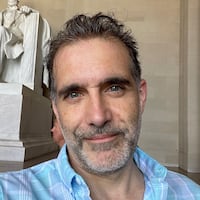Rep. John Lewis was present at so much civil rights history — has made so much civil rights history — that his stories would fill several memoirs.
Almost 20 years before his award-winning graphic-novel trilogy "MARCH" would be completed, Lewis co-authored an autobiography in 1998 with Michael D'Orso called "Walking with the Wind."
Here are a few surprising moments from that earlier memoir, all taken from the years before Lewis became chairman of the Student Nonviolent Coordinating Committee (SNCC), before his fateful crossing of the Edmund Pettus Bridge in Selma, Alabama, and before his decades of service in Congress — in other words, when much of his own personal history was ahead of him.
1) He was a notable preacher at age 15. Lewis gave his first public "trial sermon" in 1956 at Macedonia Baptist Church in Troy, Alabama, just a few days short of his 16th birthday. He writes that the sermon was inspired by the courage of Autherine Lucy, who at that time was attempting to become the first black student at the University of Alabama. Lewis' sermon that day was so popular that The Montgomery Advertiser took his photo and wrote about the emerging "boy preacher." That reputation followed him when he became a student at American Baptist Theological Seminary, so much so that when Lewis met Martin Luther King Jr. for the first time, King said to him, "I just want to meet the boy from Troy."
2) He intended to integrate Troy State. That first meeting between Lewis and King had a purpose. The 18-year-old Lewis had written to King about his intention to apply to Troy State University. After seeing what Autherine Lucy had experienced at the University of Alabama, Lewis knew he’d need backup. He met with King and Ralph David Abernathy in Montgomery, Alabama, to request support, both public and financial, in his quest to integrate Troy State. Lewis wrote in his memoir that King promised the necessary support but advised him to discuss it with his parents. At home, his parents agreed at first, but they eventually changed their minds as they considered the possible repercussions. Lewis reluctantly abandoned the plan.
3) His parents were ashamed of him. At first, anyway, when they learned he had been arrested during the 1960 student protests in Nashville, Tennessee. “I lost my family,” Lewis wrote in his memoir. The stigma of their son going to jail was too great for them to bear. Their disapproval was “a schism that would take years to close,” Lewis wrote. “The movement became my family.” And although he would remain close to his parents, Lewis said that his time in the movement was something they never understood. “To them, it was as if I was living in a foreign country.”
4) He missed his bus to the Freedom Rides. In the spring of 1961, Lewis was to join 12 other riders — black and white — who would board a Greyhound bus in Washington, D.C., and attempt to ride it to New Orleans. The organizer of this dangerous mission was the Congress of Racial Equality (CORE), which had accepted Lewis’ application and sent him a bus ticket to Washington. Two of Lewis’ friends in the Nashville movement, James Bevel and Bernard LaFayette, drove him to the bus station only to learn that the bus from Nashville to Washington had already left. Lewis wrote, “We threw my bag back in Bevel’s car, floored it east and caught up in Murfreesboro.”
5) He missed graduation because he was in Parchman prison. Lewis and other Freedom Riders had already experienced exceptional violence in Alabama when their bus drove through Mississippi in May 1961. Despite having a state trooper escort, the group was arrested when they arrived in Jackson. Lewis in particular was arrested while using a “white” men’s room at the bus station. This arrest, one of 45 in Lewis’ lifetime, is immortalized in his most famous mugshot, one that shows him smirking mischievously (see image at top). The Riders were kept on a prison farm for two weeks. Then they were transferred in the dead of night to the South’s most notorious prison — Parchman Farm Penitentiary. Lewis was held at Parchman for three weeks, during which time he was able to send a letter to the registrar at American Baptist Theological Seminary. He explained to the registrar that he wouldn’t be attending commencement because, as he wrote in his memoir, “there was no better place for me to be than right where I was.”
About the Author
Keep Reading
The Latest
Featured



